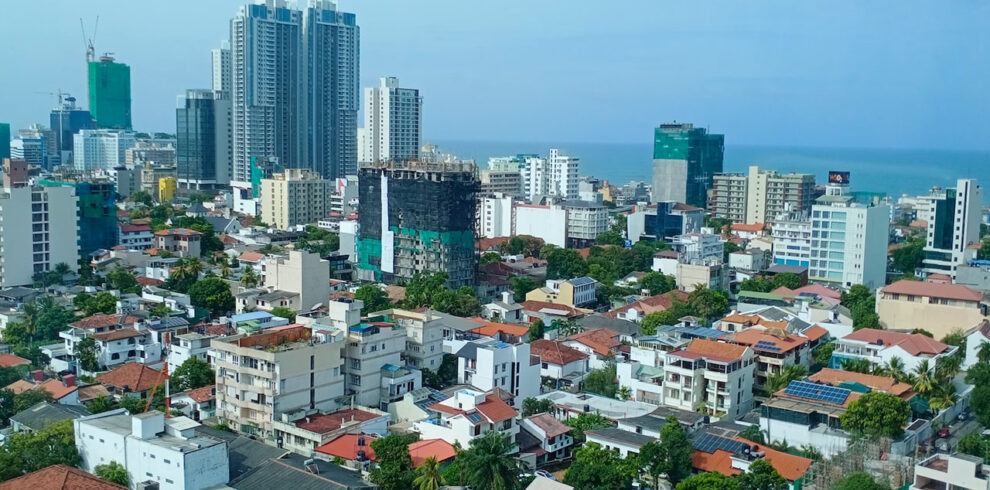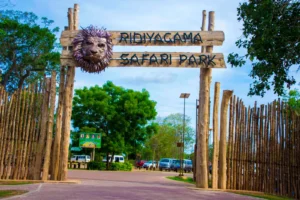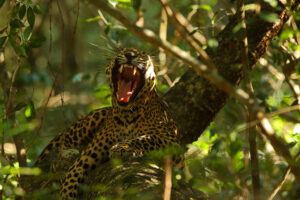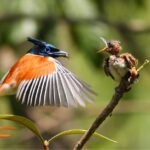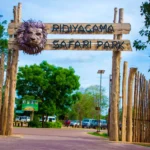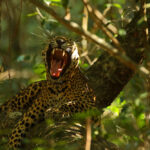Colombo is the commercial capital of Sri Lanka and lies on the west cost of the island approximately 38 km off the Bandaranayake International Airport (BIA) at Katunayake.
Colombo’s natural harbour was known by the ancient traders for over 2000 years due its strategic position of the east-west sea trade route. Colombo offers you a mixture of modern life with historical and natural sites few other cities can offer.
Galle Face Green
The Galle Face is a promenade which stretches for a half kilometre along the coast in the heart of the financial and business district of Colombo, Sri Lanka.
The Galle Face Green is currently a 5 hectare ribbon strip of land between Galle Road and the Indian Ocean which is now the largest open space in Colombo. This is a popular destination for children, vendors, teenagers, lovers, kite flyers, merrymakers and all those who want to indulge in their favourite pastimes next to the sea under the open sky. On Saturday and Sunday evenings, the land is busy with day trippers, picnickers and food vendors. There are two large hotels that border the strip; the Ceylon Inter-Continental Hotel and at the other by the quaint Galle Face Hotel, one of Sri Lanka’s oldest and most popular hotels, with a variety of old world charm including old furniture, hand carved doors, balconies and high ceilings.
Old Parliament Building
This is a Neo-Baroque-style building building built in 1930 to house the Legislative Council of Ceylon during the British occupation of the country. This building was used as the parliament after independence until 1983, when the parliament was moved to the new building at Sri Jayawardhanapura, Kotte. Currently it houses the Presidential Secretariat.
Old Light House
This lighthouse is not operational any more, but functions as a clock tower and is designated as a monument. It is located at the junction of Chatham Street and Janadhipathi Mawatha (formally Queens road) in Colombo fort.
Gangaramaya Temple
The beautiful Gangaramaya Temple is famous for its imposing buildings, and is complete with a chetiya, bo tree, image house, Simamalaka, relic chamber containing the relics of the Buddha and Arahat Seevali, museum, library, pirivena, and residential, education and alms halls. It is decorated with stone carvings, brass work and many other forms of Buddhist art.
Commonwealth War Memorial at the Vihara Mahadevi Park
This Cenotaph War Memorial was built by the British as a tribute to the armed forces of commonwealth countries who made the supreme sacrifice during the world war I. This memorial was initially built on the Galle Face Green in 1920’s but it was dismantled during World War II for the fear of being used as a marker by the Japanese for aerial attacks. After the war this memorial was moved to the Viharamahadevi Park and rebuilt again.
Independence Hall
This hall build to commemorate the freedom from British Rule lies in a tranquil surrounding in Colombo. It was built to have a seating capacity of 25,000 on the assembly ground. From the beginning this memorial was built to be worthy of the glorious history of the country.
But the hall was rarely used for such large functions and part of the ground is now converted to a sports complex. A jogging path has now being built around this area and this a popular gathering place for kids as well as adults.
Colombo National Museum
The Colombo Museum as it was called at the beginning was established on 1st January 1877. It founder was Sir William Henry Gregory, the British Governor of Ceylon (Sri Lanka) at the time.
The museum houses a very impressive collection buddhist and hindu statues going back to pre christian era and a collection of over 4000 palm leaf manuscripts.
Dutch Period Museum
Located in middle of Maliban Street in the pettah market, this museum is in fact is the 17th centaury residence of the Dutch Governor. The building is well kept and has a nice courtyard garden. It has good collection of artifacts from the Dutch period.
Time of Operation : Daily 09.00 hrs to 17.00 hrs except on Fridays
Nelum Pokuna (Lotus Pond) Theater
The latest attraction in Colombo. This theatre is a fully equipped state of the art performance centre, meant for large scale theatrical productions. The theatre consists of two venues for performances, which includes the main auditorium and an open air amphitheatre.The design of this building is inspired by the Lotus Pond in the Polonnaruwa built during 9-11th centauries
National Art Gallery
This lies close proximity to National Museum and the Nelum Pokuna Theatre. In addition to exhibitions held by various artists it has a permanent collection of portraits and landscapes on exhibition.
Planetarium
The Planetarium established in 1965, was a special feature of the Industrial Exhibition held in Colombo that year. Designed by renowned Engineer Dr. A.N.S. Kulasinghe, its inner dome, taking the shape of a lotus in full bloom, was constructed by Engineers from Germany. The artificial sky where one could glimpse the night sky during day time is created on a domed screen above an auditorium which could seat 500 visitors.
Show times : Tuesday to Saturday at 10.00 a.m. and 2.00 p.m. One show takes about 1 ½ hours.
Awkana Buddha Replica
This is a replica built around 1970 of the awkana statue which was carved out of rock during the 6th century AD. This lies in front of the Bandaranaike Memorial International Conference Hall (BMICH).
Deepaduttaramaya Temple
The oldest temple in Colombo. Over 300 years old. Commonly known as the Thai Temple due to close links with the Thai Royal Family. Lies in Kotahena
National Zoological Garden – Dehiwala
National Zoological Gardens of Sri Lanka is a zoological garden in Dehiwala, Sri Lanka, founded in 1936. It is home to various birds, mammals, reptiles, fish and amphibians. The zoo not only exhibits animals from Sri Lanka, but also exhibits species from across Asian and other parts of the globe.
Pepiliyana Sunethradevi Pirivena
King Parakramabahu VI, built one of Sri Lanka’s greatest spiritual and historic monuments in honor of his mother, Queen Sunethradevi, whom he is said to have been extremely close to.
The King, a great warrior who united Sri Lanka for the last time before foreign invasion, spent his most trying times before acquiring the crown, in the protection of his mother. The two had a deep and lasting bond. Touching, but there’s more to the Pepiliyana Sunethradevi Pirivena than that, according to its present incumbent chief priest. “I dug a bit deeper into the history of this temple and found something quite interesting,” said the monk.
Bellanwila Rajamaha Viharaya
Bellanwila Rajamaha Viharaya is a Buddhist temple situated in Bellanwila, Colombo District, Sri Lanka.[2] Located around 12 km south to the Colombo city, near Dehiwala – Maharagama road, the temple attracts hundreds of devotees daily and is famous for its annual Esala Perehera festival which usually takes place in the month of August or September. One of the most venerated Buddhist temples in Sri Lanka, many devotees flock to worship the sacred Bo tree of Bellanwila Rajamaha Vihara, which is considered to be one of the first offshoots of Jaya Sri Maha Bodhi in Anuradhapura, Sri Lanka
Kelaniya Raja Maha Viharaya
The Kelaniya Raja Maha Vihara or Kelaniya Temple is a Buddhist temple in Kelaniya, Sri Lanka. It is located 11 km north-east of Colombo. The current chief incumbent is Venerable Professor Kollupitiye Mahinda Sangharakkhitha Thera
Kalutara Bodhiya
Kalutara Bodhiya is a Bodhi tree located in Kalutara, Western Province of Sri Lanka. Situated on the Galle Colombo main road, by the side of Kalu River just south to the Kalutara city, it is believed to be one of the 32 saplings of the Jaya Sri Maha Bodhi in Anuradhapura, Sri Lanka.
King Sri Wickrama Rajasinghe Prison Cell
The King’s Prison Cell in Colombo is one of the historical icons for Srilankan and Foreign tourist who visits to Colombo.The King Sri Wickrama Rajasinghe Prison Cell is located near to world Trade center and Opposite to the Bank of Ceylon Headquarters. (Inside Ceylinco Group Headquarters land)Sir Wickrama Rajasinghe, last king of Kandy (1798 to 1815) was surrendered to Sir. Robert Brownrigg, the British governor for the coastal areas of the island on 118th February 1815. After a successful invasion to the hill country, the King Sir Wickrama Rajasinghe was brought to Colombo and Temporary imprisoned in this specific Chamber within the palace near the south gateway to Galle in Colombo Fort.The Ex King, His Queen and the others were taken to the Shop H.M.S Cornwallis under the supervision of Capt. O. Brine and Depart t Vellore in Madras on 24th January 1816, where he lived as a Prisoner of war and Died on 30th January 1832.
Colombo Fort
Fort (Colombo) is the central business district of Colombo in Sri Lanka. It is the financial district of Colombo and the location of the Colombo Stock Exchange and the World Trade Centre of Colombo from which the CSE operates. It is also the location of the Bank of Ceylon headquarters.
Khan Clock Tower
The Khan Clock Tower was built in Colombo, Sri Lanka by the Khan Family of Bombay. The Clock Tower is a popular landmark and marks the entrance to Pettah Market. The Clock Tower was built in the early 20th century by the family of Framjee Bhikhajee Khan.
Colombo Lighthouse
Colombo Lighthouse is an important watchtower in Sri Lanka located at Galbokkka Point, south of the Port of Colombo. This lighthouse is one of the prominent landmarks in Colombo city, providing a beautiful panoramic view of the Indian Ocean from 50 meters above. At the base, there is a naval gun battery for performing traditional gun salute. Positioned in Colombo fort on the oceanfront along the marine drive, Colombo Lighthouse is operated by the Ports Authority of Sri Lanka.
Jami Ul-Alfar Mosque
Colombo Red Mosque, also known as Jami Ul-Alfar Masjid, is literally an architectural wonder for the world that would stun you with its unusual color patterns and unconventional yet amazing design. Located in Pettah district, this oldest mosque towers over the buildings and streets in the neighborhood with its tall minarets and had been once a reliable landmark for the sailors coming towards Colombo port. Here both men and women are granted access, but you have to be clad in decent clothes and cover your head and respect the customs. The unconventional red tone has won the name,’ red mosque’, for this beauty.
Kayman’s Gate
Kayman’s Gate was an entrance to the former Colombo Fort located at the foot of the Wolvendaal Hill in the Pettah district of Colombo, Sri Lanka. A historic free-standing bell tower still stands at the site, now at the intersection of Main and 4th Cross Streets.
Arulmihu Sivasubramania Swami Kovil
This temple has a long history of about 125 years and was built to worship Lord Muruga, otherwise known as God Kataragama. This is of great importance to the Hindu people as well as the Buddhist people who are found traveling in great numbers to devoutly worship at the shrine of Kataragama on the south of the Island. The most outstanding sight is the tower known as Rajakopuram. This tower was built in 1994 fully embellished with colorful statues of Hindu deities. It is also accompanied by two smaller towers and a clock house. The construction of this tower was followed by a celebration called Kumbabishekam which is a traditional ceremony that is held after rehabilitation or a reconstruction of a temple.
Colombo Old Town Hall Building and Museum
Hidden in the busy Pettah Market lies a the old town hall building of then Ceylon hidden by the hawker stalls. Built in 1873, the mastermind behind this wonderful creation was British architect J. G. Smither who himself designed the furniture to match the woodwork of the building. The unique feature of this painstakingly designed furniture is the back rest of the chairs which resembled the design of wooden arches in each window.Town hall was the first civic building at the time to be opened in Colombo. Its architecture has the overall features of a Neo-gothic building with its predominance of pointed arches and cast iron columns. The building was used as the municipal headquarters from 1873-1924 until in 1925 it was moved to a new premises.
Captain’s Garden Siva Kovil in Maradana (Sri Kaileswaram Kovil
There are two kovils here, the Sri Balaselvanayagam Devasthanam (also called the Sri Bala Vinayaga Moorthy Devasthanam and the Sri Kailasanathar Swamy Devasthanam. The first kovil is dedicated to God Ganapathi or Ganesh while the second one is dedicated to Lord Shiva. These two kovils are supposed to be the oldest kovils in the city of Colombo.
Wolvendaal Church
Wolvendaal Church (Wolvendaalse Kerk) is located in Pettah, a neighbourhood of Colombo. It is one of the most important Dutch Colonial era buildings in Sri Lanka, and is one of the oldest Protestant churches still in use in the country.In 1736 Governor of Ceylon, Gustaaf Willem van Imhoff, sought approval from the Dutch East India Company (Vereenigde Oost-Indische Compagnie or VOC) to demolish the existing church (Kasteel Kerk) within the Colombo Fort and construct a new one on the same site. However, the VOC refused this request, and it wasn’t until the arrival of Governor Julius Valentyn Stein van Gollenesse in 1743 that the impasse was overcome. He decided that the new church would be erected in the area beyond the city walls, which at the time was swamp and marshland. The Europeans mistook the packs of roaming jackals for wolves, and the area became known as Wolvendaal (Wolf’s Dale or Wolf’s Valley). The site that was selected was on a hill which commanded views across the town and over the harbour and was in proximity to the town’s entrance. The site was also occupied by a small church, which had existed from the earliest period of Dutch occupation, when the Wolvendaal neighbourhood was a quiet suburban parish.
Captain’s Garden Siva Kovil in Maradana (Sri Kaileswaram Kovil)
Located in the heart of Colombo in Maradana, Sri Kaileswaram Kovil in the Captains Garden is considered the oldest Sivan Kovil in Colombo. Though the kovil is situated in center of Maradana, this is also isolated from all sides with a network of railway tracks this not so easily accessible as you would think. The entrance to Kovil Street is near a popular landmark, the second hand bookshops of D.R. Wijewardene Mawatha and the road goes over the Fort railway lines and ends at the Kovil grounds.There are number of wonderful religious places around colombo but some of these places do not welcome visitors so readily or even allow photography. Even though this kovil as a active place of worship you are made welcome to place as long as you are decently dressed and photography is allowed at a nominal fee.
Deepaduttaramaya of Kotahena
It was a temple where Sri Lankan Buddhist history was made. Deepaduttaramaya built initially in 1785 was the first Buddhist temple in Colombo and was home to Ven. Migettuewatte Sri Gunananda Thera, the leader of the famous ‘Panadura Vadaya’ and a great orator. It was where the Buddhist flag was designed and hoisted for the first time and the temple where generations of Thai royalty had worshiped and bestowed gifts and donations since the early 20th century.The temple was built during the Dutch period when the ruling Dutch authorities did not approve the construction of a temple within the territ ory when Buddhists had to travel to Kelaniya or to Kotte for worship. However, Mudliyar Thabrew Ubayakulatunga Wijesiriwardhana succeeded in convincing Dutch Governor, Von Engel Beck, to grant him permission to build a temple as an extension to his house. He dedicated the newly built temple to Ven. Seenigama Dhammarakkitha Thera. Those were the glorious days of Deepaduttaramaya. A branch of the Jaya Sri Maha Bodhi in India was negotiated from Mahantha, who was in charge of the place and was planted at the temple in the late 18th century and it became a place of worship to many a Buddhist in Colombo.
National Art Gallery
The National Art Gallery in Colombo, Sri Lanka was the first state-sponsored art gallery built in the country. The gallery is located in Cinnamon Gardens near the Nelum Pokuna Mahinda Rajapaksa Theatre, Viharamahadevi Park, the National Museum of Colombo, the Town Hall, Colombo and Colombo Public Library.
Beddagana Wetland Park
Beddagana Wetland Park is a wetland park situated on Rampart Road in Sri Jayawardenepura, Kotte. It is a great place to embrace Mother Nature with so much to do such as bird watching and taking a stroll sinking in the beauty surrounding it. It is a naturally beautiful place with artistic landscaping and lush greenery. There are educational tours such as boat rides identifying different species of butterflies, dragonflies and damselflies. It is the perfect place for nature lovers.

OVERVIEW Explore the city of Colombo, a quaint merging of the old with new, in a full day tour covering…

